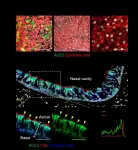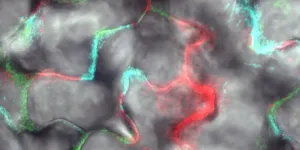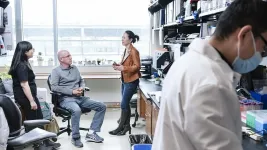Study identifies risk factors for severe COVID-19 in individuals with sickle cell disease
Researchers urge high-risk patients to get COVID-19 vaccine
2021-07-01
(Press-News.org) New research published today in the journal Blood Advances finds that certain factors, such as a history of severe pain episodes and coexisting organ conditions, increase the risk of severe COVID-19 illness, including hospitalization, in individuals living with sickle cell disease (SCD). According to researchers, the study results underscore the need for COVID-19 risk reduction strategies and vaccination for this medically vulnerable population.
SCD is the most common inherited red blood cell disorder in the United States, affecting an estimated 100,000 people. According to the Centers for Disease Control and Prevention, SCD affects one out of every 365 Black or African American births and one out of every 16,300 Hispanic American births. The condition can cause severe pain, joint and organ damage, and stroke; these conditions predispose individuals with SCD to worse outcomes with infections, including infection with COVID-19. Previous research has shown patients with COVID-19 and SCD are at greater risks for hospitalization compared with Black individuals without SCD who become infected.
The new study draws data from SECURE-SCD, an international registry that collects information about COVID-19 infections in individuals living with SCD, including details on hospitalization, severity, management strategies, and complications.
Researchers assessed reports on 750 children and adults submitted to the registry between March 2020 and March 2021. Half the patients they studied were children aged 18 and under, and half were adults with a median age of 31 years old. Ninety percent of participants were identified as Black and 7% as Hispanic or Latino.
The researchers found that children living with SCD who had previously suffered more than two pain events requiring acute care were 2.2 times more likely to be hospitalized for COVID-19 and more than 3 times likely to suffer severe COVID-19 illness. A history of pain events was also found to be a risk factor for adults, as those with more than two prior acute care visits for pain were 1.8 times more likely to be hospitalized with COVID-19 and 1.9 times more likely to suffer severe COVID-19 illness. SCD-related heart, lung, and kidney conditions were associated with higher risk of severe illness in children, while SCD-related heart and lung conditions were also associated with higher risk of hospitalization. However, these conditions did not have the same effect in adults.
"This study tells us that all individuals with sickle cell disease are not at equal levels of risk," said study author Lana Mucalo, MD, of the Medical College of Wisconsin. "Patients with a history of pain, as well as individuals with coexisting organ conditions, need to be even more careful to avoid COVID-19 infection than those without any comorbidities," said Dr. Mucalo.
Dr. Mucalo also noted that now that COVID-19 vaccines are available, physicians and patients alike need to recognize these risk factors when considering vaccination. "Providers that care for individuals living with sickle cell disease should recommend vaccination, particularly for those with these comorbidities that put them at greater risk."
Pain is the most common complication of SCD, and severe pain is the leading cause of emergency department visits and hospitalizations for people with this disease. Notably, this study found that pain was also the most common presenting symptom during COVID-19 illness in both children and adults living with SCD, and that many patients only had pain as their presenting COVID-19 symptom. "This means individuals with sickle cell disease who come to the hospital presenting with pain should also be tested for COVID-19," said Dr. Mucalo.
The research team also sought to understand the effects of hydroxyurea, a drug commonly prescribed to individuals with SCD to reduce the frequency of pain episodes, on COVID-19. About half of the 750 patients studied were taking hydroxyurea, and the researchers found that hydroxyurea use was associated with lower risk of presenting with pain during COVID-19 in adults living with SCD. However, hydroxyurea did not affect whether an individual would develop a serious case of COVID-19 or need to be hospitalized in children or adults.
"Early in the COVID-19 pandemic, physicians were worried about whether to use hydroxyurea simply because we did not yet know the effects," said Dr. Mucalo. "Now we can see that while it does not affect COVID-19 severity, it does help to lower the incidence of pain episodes in adults with sickle cell disease, so those who are using it for treatment of their sickle cell conditions should not stop using it."
The analysis was limited to patient data reported to SECURE-SCD; given the voluntary reporting system of the registry, it does not capture all known cases of patients with sickle cell disease and COVID-19 infection.
INFORMATION:
SECURE-SCD is supported by Doris Duke Charitable Foundation.
ELSE PRESS RELEASES FROM THIS DATE:
2021-07-01
Understanding how viral infection occurs can provide important clues for researchers to develop strategies to prevent viral transmission and develop effective therapeutic agents and vaccines. SARS-CoV-2, the causative agent of COVID-19, enters the host cells through interaction between the virus's spike protein and the extracellular receptor binding domain of ACE2. The viral entry into the cells is completed by various proteases, which allow the viral and cell membranes to fuse together. While it is known that the upper respiratory tract becomes compromised in the early infection, the exact types of the cells that the virus infects at the earliest stage have not yet been identified.
Led by Director ...
2021-07-01
New research from the Institute of Psychiatry, Psychology & Neuroscience (IoPPN) at King's College London, in collaboration with the University of Liverpool and the Karolinska Institute, has shown that many of the symptoms in fibromyalgia syndrome (FMS) are caused by antibodies that increase the activity of pain-sensing nerves throughout the body.
The results show that fibromyalgia is a disease of the immune system, rather than the currently held view that it originates in the brain.
The study, published today in the Journal of Clinical Investigation, demonstrates that the increased ...
2021-07-01
Extreme differences in flight altitude between day and night may have been an undetected pattern amongst migratory birds - until now. The observation was made by researchers at Lund University in Sweden in a study of great snipes, where they also measured a new altitude record for migratory birds, irrespective of the species, reaching 8 700 metres.
Great snipes are shorebirds that breed in Sweden, among other places, and spend the winter in areas near the equator in Africa. Previous studies have shown that great snipes make long marathon flights of up to 6 000 kilometres lasting 60-90 hours when they migrate between breeding sites in Sweden and wintering ...
2021-07-01
Chatbots have already become a part of our everyday lives with their quick and intuitive way to complete tasks like scheduling and finding information using natural language conversations. Researchers at Aalto University have now harnessed the power of chatbots to help designers and developers develop new apps and allow end users to find information on the apps on their devices.
The chatbot -- 'Hey GUI' (pronounced goo-ee), short for Graphical User Interface, which will be presented at ACM Designing Interactive Systems 2021 on 1 July -- can answer questions by showing images and screenshots of apps, or through simple text phrases.
"Hey GUI eliminates the need for coding skills or technical ...
2021-07-01
Hundreds of different bacterial species live in and on leaves and roots of plants. A research team led by Julia Vorholt from the Institute of Microbiology at ETH Zurich, together with colleagues in Germany, first inventoried and categorised these bacteria six years ago. Back then, they isolated 224 strains from the various bacterial groups that live on the leaves of thale cress (Arabidopsis thaliana). These can be assembled into simplified, or "synthetic" plant microbiomes. The researchers thus laid the foundations for their two new studies, which were just published in the journals Nature Plants and Nature Microbiology.
Volume control of the plant response
In the first study, the researchers investigated ...
2021-07-01
A team of scientists has devised a more accurate way to predict the effects of climate change on plants and animals -- and whether some will survive at all.
Frequently, ecologists assess an organism's fitness relative to the climate by quantifying its functional traits.
"These are physical properties you can measure -- height, diameter, the thickness of a tree," said UC Riverside biologist Tim Higham. "We believe more information is needed to understand how living things will respond to a changing world."
The team, led by Higham, outlines an alternative model for researchers in an article ...
2021-07-01
NEW YORK, NY (July 1, 2021)--Lowering levels of a hormone called PTHrP can prevent metastases and improve survival in mice with pancreatic cancer and could lead to a new way to treat patients, according to a study from cancer researchers at Columbia University Vagelos College of Physicians and Surgeons and Herbert Irving Comprehensive Cancer Center and with collaborators at the University of Pennsylvania.
When patients are first diagnosed with pancreatic cancer, the cancer usually has spread to other organs. Because of these metastases, nearly all patients will succumb to their cancer within one year of diagnosis, but no drugs exist to prevent metastasis.
In an effort to find treatments, cancer researchers at Columbia--led by ...
2021-07-01
What if a microscope allowed us to explore the 3D microcosm of blood vessels, nerves, and cancer cells instantaneously in virtual reality? What if it could provide views from multiple directions in real time without physically moving the specimen and worked up to 100 times faster than current technology?
UT Southwestern scientists collaborated with colleagues in England and Australia to build and test a novel optical device that converts commonly used microscopes into multiangle projection imaging systems. The invention, described in an article in today's Nature Methods, could open new avenues ...
2021-07-01
SAN FRANCISCO, CA--June 28, 2021--While vaccines are doing a remarkable job of slowing the COVID-19 pandemic, infected people can still die from severe illness and new medications to treat them have been slow to arise. What kills these patients in the end doesn't seem to be the virus itself, but an over-reaction of their immune system that leads to massive inflammation and tissue damage.
By studying a type of immune cells called T cells, a team of Gladstone scientists has uncovered fundamental differences between patients who overcome severe COVID-19 and those who succumb to it. The team, working together with researchers from UC San Francisco and Emory University, also found that dying patients harbor relatively large numbers of T cells able to infiltrate the lung, which may contribute ...
2021-07-01
BUFFALO, N.Y. -- Patients with Type 2 diabetes who were prescribed SGLT2 inhibitors lost more weight than patients who received GLP-1 receptor agonists, according to a University at Buffalo-led study.
The research, which sought to evaluate the difference in weight loss caused by the antidiabetic medications -- both of which work to control blood sugar levels -- found that among 72 patients, people using SGLT2 inhibitors experienced a median weight loss of more than 6 pounds, while those on GLP-1 receptor agonists lost a median of 2.5 pounds.
The findings, published last month ...
LAST 30 PRESS RELEASES:
[Press-News.org] Study identifies risk factors for severe COVID-19 in individuals with sickle cell disease
Researchers urge high-risk patients to get COVID-19 vaccine





